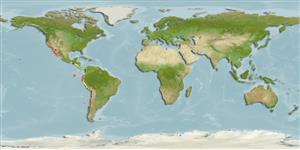Ελασμοβράγχιοι (καρχαρίες και σαλάχια) (sharks and rays) >
Carcharhiniformes (Ground sharks) >
Scyliorhinidae (Cat sharks) > Scyliorhininae
Etymology: Cephaloscyllium: cephalus, from kephale (Gr.), head, referring to its very broad and depressed head; skylion, Greek for dogfish or small shark (See ETYFish); ventriosum: venter (L.), belly; -osus, Latin suffix connoting fullness, referring to its inflatable stomach (See ETYFish).
More on author: Garman.
Environment: milieu / climate zone / εύρος βάθους / distribution range
Οικολογία
Θαλασσινό(ά) βενθικό(ς); εύρος βάθους 5 - 457 m (Ref. 96339), usually 5 - 37 m (Ref. 244). Subtropical; 40°N - 37°S, 126°W - 71°W (Ref. 55293)
Eastern Pacific: central California, USA to the Gulf of California and southern Mexico; central Chile.
Μέγεθος / Βάρος / Age
Γεννητική Ωρίμανση: Lm ? range ? - ? cm
Max length : 110 cm TL αρσενικό/απροσδιόριστο; (Ref. 96339)
Found on the continental shelves and upper slopes from inshore to deeper waters. Prefers rocky, algal-covered areas of kelp beds. Nocturnal. Feeds on bony fishes, alive and dead, and probably crustaceans. Can inflate its stomach with water or air. Oviparous. Can live in tanks for several years and females can lay eggs in captivity. Occurs in aggregations while resting, sometimes piled one on top of the other. Sometimes caught by sport divers but not used.
Life cycle and mating behavior
Γεννητική Ωρίμανση | Αναπαραγωγή | Γεννοβολία | Αβγά | Γονιμότητα | Προνύμφες
Oviparous, paired eggs are laid. Embryos feed solely on yolk (Ref. 50449).
Compagno, L.J.V., 1984. FAO Species Catalogue. Vol. 4. Sharks of the world. An annotated and illustrated catalogue of shark species known to date. Part 2 - Carcharhiniformes. FAO Fish. Synop. 125(4/2):251-655. Rome: FAO. (Ref. 244)
IUCN Red List Status (Ref. 130435: Version 2024-2)
Threat to humans
Harmless
Human uses
αλιεία: χωρίς ενδιαφέρον; αλιεία αναψυχής: ναί; Ενυδρείο: Δημόσια ενυδρεία
Εργαλεία
Special reports
Download XML
Διαδικτυακές πηγές
Estimates based on models
Preferred temperature (Αναφ.
123201): 14.8 - 28.1, mean 22.3 °C (based on 90 cells).
Phylogenetic diversity index (Αναφ.
82804): PD
50 = 0.5000 [Uniqueness, from 0.5 = low to 2.0 = high].
Bayesian length-weight: a=0.00263 (0.00138 - 0.00502), b=3.21 (3.04 - 3.38), in cm total length, based on LWR estimates for this (Sub)family-body shape (Ref.
93245).
Τροφικό Επίπεδο (Αναφ.
69278): 3.9 ±0.61 se; based on food items.
Ελαστικότητα (Αναφ.
120179): Χαμηλό, ελάχιστος χρόνος για διπλασιασμό πληθυσμού 4,5 - 14 έτη (Fec assumed to be <100).
Fishing Vulnerability (Ref.
59153): High to very high vulnerability (66 of 100).
🛈
